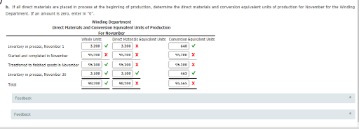Content

If companies have discontinued operations, the results are shown on the income statement below the operational results from current operations. Corporations may also incorporate supplementary notes and may be subject to an external independent audit to verify their accuracy and fairness of presentation. These notes provide detailed explanations of the What Is A Financial Statement? accounts and financial information contained in the main reports outlined above. This is done either to increase the value of the existing shares or to prevent various shareholders from controlling the company. Long-term DebtLong-term debt is the debt taken by the company that gets due or is payable after one year on the date of the balance sheet.
What are the 3 types of financial statements?
The income statement, balance sheet, and statement of cash flows are required financial statements. These three statements are informative tools that traders can use to analyze a company's financial strength and provide a quick picture of a company's financial health and underlying value.
Listed below are just some of the many ratios that investors calculate from information on financial statements and then use to evaluate a company. These are expenses that go toward supporting a company’s operations for a given period – for example, salaries of administrative personnel and costs of researching new products. Operating expenses are different from “costs of sales,” which were deducted above, because operating expenses cannot be linked directly to the production of the products or services being sold.
Understanding Cash Flow Statement Data
Total liabilities and equity were $338.9 billion, which equals the total assets for the period. The statement of changes in equity records how profits are retained within a company for future growth or distributed to external parties. A financial statement gives an overall view of the condition of the business and whether there are any warning signs of possible future problems. A bank or other institution usually looks to the financial statement as the first indicator of how the business is performing and if there is a need for further investigation. Business owners may not need all the details, but they definitely need to understand the BIG PICTURE of their current financial and cash positions.
A balance sheet shows a snapshot of a company’s assets, liabilities and shareholders’ equity at the end of the reporting period. It does not show the flows into and out of the accounts during the period. Reported assets, liabilities, equity, income and expenses are directly related to an organization’s financial position. An income statement—or profit and loss report (P&L report), or statement of comprehensive income, or statement of revenue & expense—reports on a company’s income, expenses, and profits over a stated period.
Types of Financial Statements: Income Statement
The income statement is also known as a profit and loss statement, statement of operation, statement of financial result or income, or earnings statement. Financial statements are important because they provide financial information that measures financial performance, resources, and liquidity. Financial statements let users review the historical cash flow of the business and significant disclosures, including Management’s Discussion and Analysis (MD&A).
- It is used by lenders and investors to check a business’s financial health and earnings potential.
- 84% of retail investor accounts lose money when trading CFDs with this provider.
- Additional amounts over par valued paid for the preferred stock or common stock are separately listed as balance sheet line items for paid-in capital.
- We also reference original research from other reputable publishers where appropriate.
- Efficient use of money and time is important us and our clients, so one of our top priorities is providing a high level of quality, speed of service, and affordability.
- An income statement may also be known as a profit and loss statement, showing your businesses income and outgoings over a set period.
No matter which type of financial statement it is, each of them helps assess the financial status and performance of a company based on the elements they individually take into account. Retained EarningsRetained Earnings are defined as the cumulative earnings earned by the company till the date after adjusting for the distribution of the dividend or the other distributions to the investors of the company. It is shown as the part of owner’s equity in the liability side of the balance sheet of the company. Meaning Profit After TaxProfit After Tax is the revenue left after deducting the business expenses and tax liabilities. This profit is reflected in the Profit & Loss statement of the business. If a company has a debt-to-equity ratio of 2 to 1, it means that the company has two dollars of debt to every one dollar shareholders invest in the company.
Cash
Efficient use of money and time is important us and our clients, so one of our top priorities is providing a high level of quality, speed of service, and affordability. The IPSASB directed staff to continue to develop the draft FSDA standard into an authoritative standard. The issue of the status of the draft FSDA IPSAS will be considered https://kelleysbookkeeping.com/ when criteria have been developed for the determination of the status of a document. This post is to be used for informational purposes only and does not constitute legal, business, or tax advice. Each person should consult his or her own attorney, business advisor, or tax advisor with respect to matters referenced in this post.
- Marketable securities don’t include any balance of marketable investments with maturities of 90 days or less that are included in cash and cash equivalents on the balance sheet.
- The analysis of financial statement trends provides insights to a company’s management and shareholders.
- This post is to be used for informational purposes only and does not constitute legal, business, or tax advice.
- Accounts receivable are collected from customers, and inventory is sold to convert these current assets to cash.
- On the other hand, if the expenses, debt, and costs recorded in the statements are more than the revenue, income, and profits, the company’s performance is doubtful.
Cash Flow From Investing ActivitiesCash flow from investing activities refer to the money acquired or spent on the purchase or disposal of the fixed assets for the business purpose. For instance, the purchase of land and joint venture investment is cash outflow, while equipment sale is a cash inflow. Income taxes – The footnotes provide detailed information about the company’s current and deferred income taxes. The information is broken down by level – federal, state, local and/or foreign, and the main items that affect the company’s effective tax rate are described.
The three major financial statement reports are the balance sheet, income statement, and statement of cash flows. The primary financial statements are the statement of financial position (i.e., the balance sheet), the statement of comprehensive income , the statement of changes in equity, and the statement of cash flows. Alone, the balance sheet doesn’t provide information on trends, which is why you need to examine other financial statements, including income and cash flow statements, to fully comprehend a company’s financial position. An income statement is a financial statement that shows you the company’s income and expenditures. It also shows whether a company is making profit or loss for a given period.

